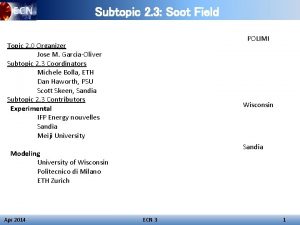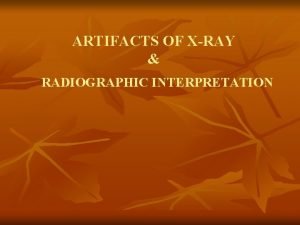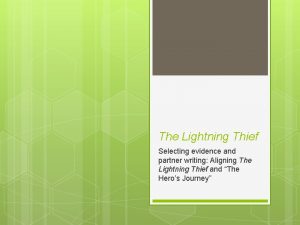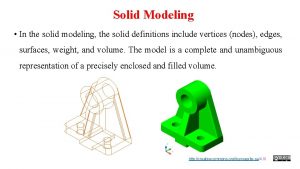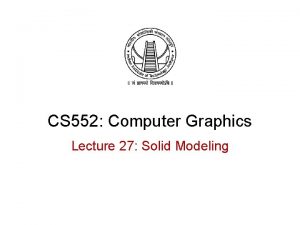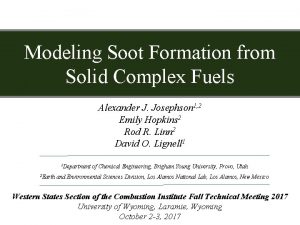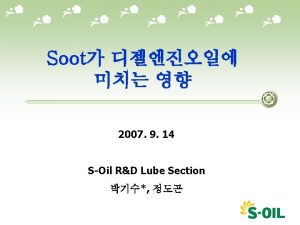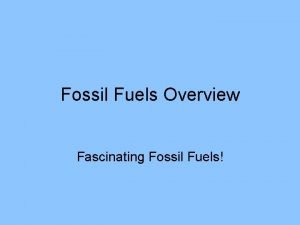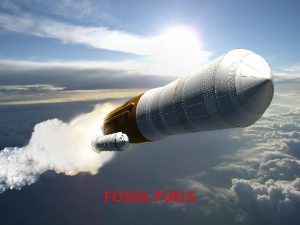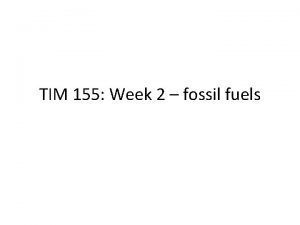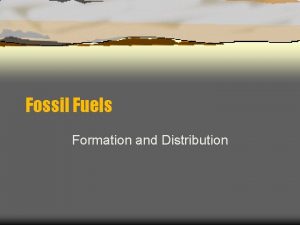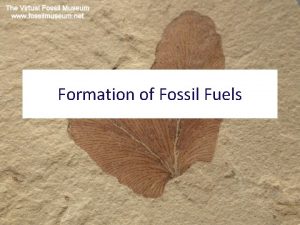Modeling Soot Formation from Solid Complex Fuels Alexander














- Slides: 14

Modeling Soot Formation from Solid Complex Fuels Alexander J. Josephson 1, 2 Emily Hopkins 2 Rod R. Linn 2 David O. Lignell 1 1 Department 2 Earth of Chemical Engineering, Brigham Young University, Provo, Utah and Environmental Sciences Division, Los Alamos National Lab, Los Alamos, New Mexico Western States Section of the Combustion Institute Fall Technical Meeting 2017 University of Wyoming, Laramie, Wyoming October 2 -3, 2017

Acknowledgements/Background • • Work began as part of the CCMSC’s PSAAP II project § Demonstrate exascale computing with V&V/UQ to more rapidly deploy new technologies for providing low cost, low emission electric power generation § Full-scale simulation of an oxy-coal boiler § Work supported by the Department of Energy, National Nuclear Security Administration, under Award Number(s) DE-NA 0002375 Work continued through the EES division at LANL § HIGRAD/FIRETEC- combines physics models that represent combustion, heat transfer, aerodynamic drag and turbulence. Designed to simulate the constantly changing, interactive relationship between fire and its environment. § Predicting solid particle emissions from wildfires § Work support comes from a large variety of sources: US Forest Service, Department of Energy, Department of Defense, and others

Soot Introduction Soot • Particles heavily impact radiative heat transfer • Changes flame chemistry • Health and environmental impacts Basic Formation Soot Precursors Nucleation Coagulation Aggregation Growth Consumption Gas-Phase Molecules • Rate-determining step is usually the formation of soot precursors • Morphology and yield of soot particles largely depended on particle residence time in the flame and other system configurations Solid Fuels Gaseous Fuels • Parent fuel breaks into small gaseous species • Parent fuel gives off tar during primary pyrolysis • PAH formed from gaseous mechanisms • Tar acts as primary soot precursor

Model Overview Soot Particles Precursor Molecules • • Transport distribution using a sectional approach • Transport soot distribution using method of moments • Transport includes source terms for: • Soot Nucleation • Precursor creation • Particle Agglomeration • Surface Reactions • Thermal Cracking • Soot Nucleation Bin Species Number Density • Interpolative closure used to resolve fractal moments PSD Moment Density

Particle Morphology • All soot precursors are assumed to be spherical • Soot particle average morphology is described using a ‘shape factor’ introduced by Balthasar and Frenklach (2005) • d is a scale • d = 2/3 implies perfectly spherical particles • d = 1 implies particles are arranged in a manner to produce the maximum possible surface area for that given mass • Md is another transported moments with resolved terms for nucleation and surface reactions, • Added another term for particle agglomeration

Model Details- Soot Precursors • Formation • • • Categorize into four types (Phenol, Toluene, Naphthalene, and Benzene) Type amounts based on characteristics of original fuel Each type cracks at a different rate (Marias 2017) Surface Growth • • Frequency of collision between precursor and soot particle Thermal Cracking • • Frequency of collision between molecules Deposition (onto the surface of a soot particle) • • Creation of pyrene Coagulation (formation of a soot particle) • • Release of tar HACA (C 2 H 2) Surface Consumption • • Oxidation (O 2 and OH) Gasification (CO 2 and H 2 O)

Model Details- Soot Particles • Nucleation • • Surface Growth • • • Available surface area accounted for by shape factor Frequency of collision between precursor and soot particle Agglomeration • • HACA Deposition • • Frequency of collision between precursors Frequency of collision between molecules Computed for both continuum and free-molecular regime Weighted average between regimes scaled by the Knudsen number Surface Consumption • • • Oxidation Gasification Rates based on recently published work

Recognized Shortcomings • Fragmentation • Particles may split (mechanically or chemically) • Particles fully consumed • No sink term for number of particles when fully consumed • Inorganics • Soot particles from solid complex fuels are known to contain inorganics • May act as catalyst for surface reactions (Na, K, S)

Validation- Coal System • Experiment conducted by Jinliang Ma at BYU (Ma, 1998) • Laminar flat flame burner • Separation system collects soot, char and ash particles • Equilibrium chemistry profile ABF mechanism • CPD model predicts tar • Sources of error

Validation- Biomass System • Experiment conducted by Trubetskaya, 2016 at Technical University of Denmark and Lulea University of Technology • Biomass gasification • Separation system collects soot, char and ash particles • Equilibrium chemistry profile ABF mechanism • CPDbio model predicts tar

Model Adaptations- Mono-dispersed • Simplifies both distributions to mono-dispersed • • Precursor distribution assumes an average molecular size • 350 g/mole for coal systems • 450 g/mole for biomass systems • 202 g/mole for gas systems Soot distribution has adjustable particle size Requires the resolution of 4 terms rather than 14+ • 1 term, number density, for precursor • 3 terms, number density, mass density, and shape factor, for soot PSD • Is the shape factor needed? Uncertainty quantification under evaluation now

Sooting Potential Model Biomass Type Mass Yield Average Mass Yield Variation (+/-) Molecular Weight Average Molecular Weight Variation Cellulose 47. 9 0. 5 460 5 Softwood Hemicellulose 30. 2 0. 6 400 6 Softwood Lignin 62. 4 1. 5 528 (502) 54 (3) Hardwood Hemicellulose 30. 5 0. 6 396 11 Hardwood Lignin 53. 5 0. 6 546 6 • • Tested tar yield of various biomass components using CPD-bio model • Varied pressure (0. 5 -1. 1 atm) • Varied temperature (600 C- 3000 C) • Varied heat-up profile (100 C/s ~ 1500 C/s) Measured • Total mass yield of tar • Average molecular size of tar • No significant variation from these parameters • Does not account for extractives • We can now build a ‘sooting potential’ of our biomass based on the component make up of the fuel

Surrogate Model Detailed Simulation Inputs Fuel Type Fuel Density Temperature Wind Velocity Turbulence Oxygen Etc. Outputs Particle Number Particle Size Surrogate Model • Uses detailed simulations to map inputs to outputs • Fit a simplified model to the inputs and outputs • • • Simplified model may be quadratic, linear, or any number of inexpensive forms Requires a ’basic unit’ • Wildland forest unit • Grassland forest unit Anytime we change the ‘basic’ unit, we must recalibrate to the new situation

Conclusions • Detailed soot model for complex solid fuels presented • Model evaluates evolution of two species: soot and precursors • Precursor PSD- sectional approach • Soot PSD- method of moments with interpolative closure • Validation work presented with good agreement for both coal and biomass systems • Some of the ongoing model adaptation presented
 3 soot in mm
3 soot in mm Soot and whitewash radiography
Soot and whitewash radiography Theodore finch quotes
Theodore finch quotes Helen erickson nursing theory
Helen erickson nursing theory Dimensional modeling vs relational modeling
Dimensional modeling vs relational modeling Solid
Solid Solid examples
Solid examples Subtractive modeling
Subtractive modeling Crystalline or amorphous
Crystalline or amorphous Example of solid solution are
Example of solid solution are Covalent molecular and covalent network
Covalent molecular and covalent network Crystalline solid and amorphous solid
Crystalline solid and amorphous solid Crystalline solid
Crystalline solid Crystalline solid and amorphous solid
Crystalline solid and amorphous solid Law of constancy of interfacial angle
Law of constancy of interfacial angle
